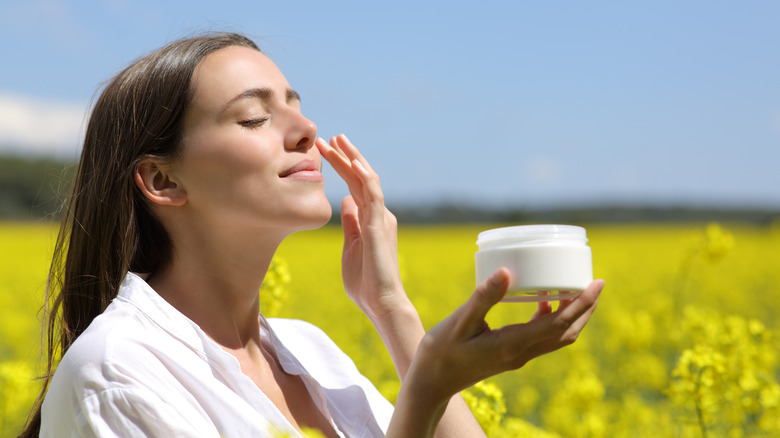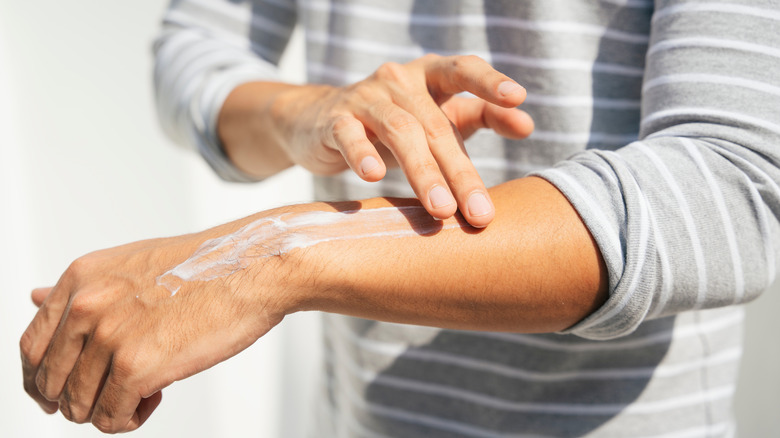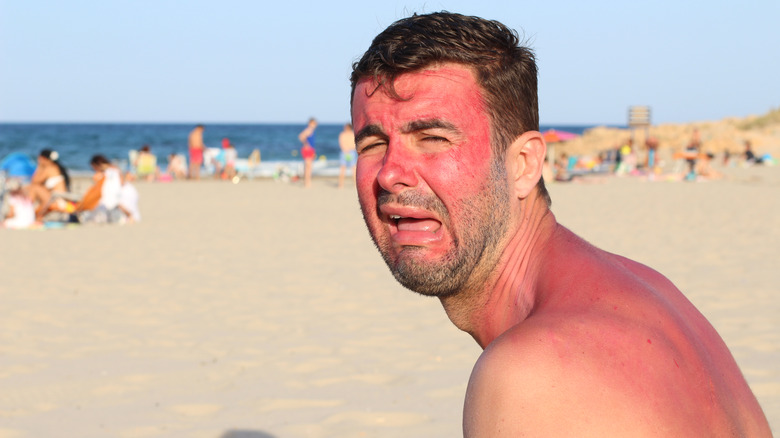How Much Sunscreen Should You Really Be Applying?
Lounging by the pool, playing outdoor sports, gardening, and simply going through your day all expose you to the sun. And when you're exposed to the sun, you've probably been told that you should apply sunscreen. To avoid uncomfortable sunburns to serious forms of cancer like melanoma, it's critical to wear sunscreen when you're exposed to the sun (per Skin Cancer Foundation). But exactly how much sunscreen should you be applying, and how often?
The National Cancer Institute defines sunscreen as a lotion, gel, or cream that contains ingredients protecting skin from harmful ultraviolet A and B radiation. You're likely familiar with the term SPF, which stands for Sun Protective Factor (via Australian Academy of Science). The number following SPF on a bottle or tube of sunscreen (such as SPF 30 or SPF 50) indicates how long that particular sunscreen protects skin.
To determine this number, manufacturers compare two patches of skin — one with sunscreen and one without. The amount of time it takes for the sunscreen-covered patch of skin to redden is divided by the amount of time it takes the patch of skin without sunscreen to redden. For instance, SPF 30 is determined when it takes 300 seconds for the sunscreen-covered patch of skin to turn red and 10 seconds for the patch of skin without sunscreen to redden. Dividing 300 by 10 yields 30, which means that the sunscreen in question should be labeled SPF 30. To keep your skin healthy, here are some sunscreen best practices.
How to apply sunscreen properly
Experts recommend always using SPF 30 or higher, according to the American Academy of Dermatology Association. Sunscreen products are generally available in the form of lotions, sprays, and sticks. When using spray sunscreen, spray until your skin noticeably glistens or has a shiny sheen to it. After you've sprayed a significant amount of sunscreen on your skin, rub it in so that you achieve full coverage. With stick sunscreen products, the best practice is to rub the product back and forth at least four times, then rub it in just as you would a spray or lotion sunscreen. Stick sunscreens are recommended for use on the backs of hands and under the eyes.
While lotion sunscreen may seem self-explanatory, you'll want to make certain that you're applying enough. The Skin Cancer Foundation recommends using the equivalent of a shot glass, or approximately 2 tablespoons, to each area of your body. You should wear sunscreen on a daily basis. However, if you're spending time directly in the sun, then sunscreen should be reapplied in two-hour intervals.
To ensure that the sunscreen products you use protect you against both ultraviolet A and B radiation, use products that are labeled as broad spectrum. There are two primary types of sunscreen on the market: chemical sunscreens and mineral blockers (per Insider). Chemical sunscreens are the most common. If you want something more organic, then you can use mineral products, which contain titanium dioxide and zinc oxide.
Risks of improper application
There is inconclusive research on whether the active ingredients in sunscreen products pose a risk to our bodies. However, there's a definitive conclusion that protecting skin from UV rays is critical. UV damage has been implicated in everything from premature aging to skin cancer (via Insider).
Unfortunately, sunscreen use is often low among adults in the United States, reports the National Cancer Institute. In particular, men are less likely than women to use sunscreen because they may associate it with being non-masculine. On the other hand, women are more likely to use sunscreen on their faces to prevent the aging effects of sun exposure. Additionally, advertisements for sunscreen products tend to be directed at women rather than at men.
There are serious risks of not wearing sunscreen, applying it incorrectly, or not applying enough. Cleveland Clinic recommends that everyone over the age of 6 months should apply sunscreen and practice sun hygiene. This can include practices like avoiding the sun in the middle of the day and wearing protective hats. Without sunscreen, you immediately risk sunburn, which occurs when blood vessels and skin cells become damaged. With repeated sunburn or improper sunscreen application, skin can more easily bruise and look discolored, wrinkled, dry, or leathery. On the extreme end is the risk of skin cancer, which is now the most diagnosed form of cancer. Whether you're outside gardening, running errands, or lounging at the beach, apply sunscreen 20 to 30 minutes before you go outside and continue to reapply every two hours.



